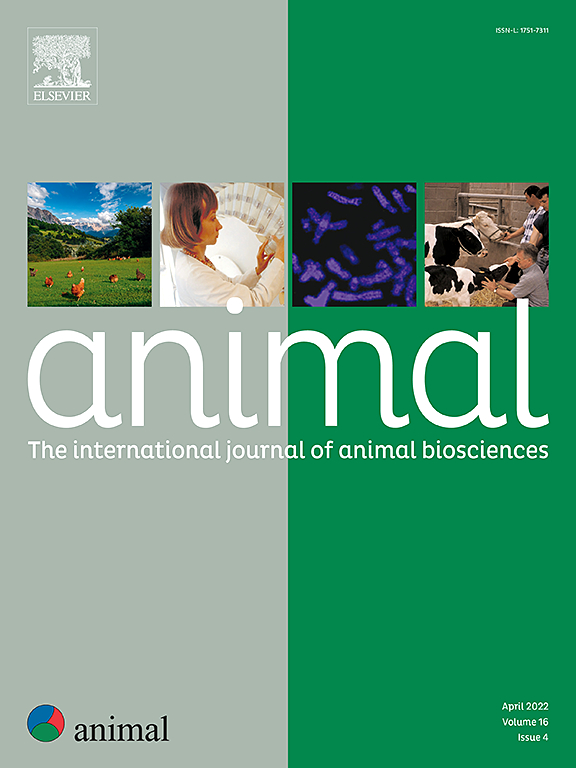Impact of live yeast and selenium supplementation on blood metabolites and rumen pH of young bulls after long-transport to the fattening unit
IF 4
2区 农林科学
Q1 AGRICULTURE, DAIRY & ANIMAL SCIENCE
引用次数: 0
Abstract
Long-distance transport and the receiving phase at the fattening unit are sources of stress for young beef cattle. This randomised controlled study involved 80 Charolais young bulls that underwent 12 h of transport from France to Italy and aimed at testing whether the animals have some benefits from the supplementation of live yeast and selenium through slow-release boluses and diet. The bulls were randomly allocated into two supplementation groups of 40 animals each, named Yeast and Control groups. Bulls of the Yeast group received a supplementation of Saccharomyces cerevisiae and selenium-enriched yeast (1.5 × 1010 CFU/bull per day of live yeast and 1.5 mg/bull per day of selenium) by two slow-release ruminal boluses 1 day before leaving France, and a live yeast supplemented diet once in Italy (8 × 109 CFU/bull per day of live yeast). Yeast and control bulls underwent the same manipulations. Individual BW and complete blood metabolic profile were assessed at the arrival to the Italian fattening unit (day 0), after 7 days (day 7), and at the end of the receiving phase (day 30). The rumen environment was continuously monitored through reticulum-rumen sensors that measured several parameters in a subsample of 60 bulls, equally distributed between Yeast and Control groups. Saccharomyces cerevisiae and selenium supplementation did not affect growth performance and metabolic profile. However, the supplementation stabilised the rumen environment by limiting the daily pH amplitude and SD and the inter-animal variability. The Yeast group increased the time spent ruminating (+39 min/day) at day 30 compared to Control group. More stable ruminal conditions are important to support beef cattle health during the receiving period at the fattening unit, when animals face the delicate transition to high-energy diets.
添加活酵母和硒对犊牛长途运输至育肥单位后血液代谢物和瘤胃pH的影响。
长途运输和育肥单位的接收阶段是小肉牛的压力来源。这项随机对照研究涉及80头夏洛莱(Charolais)公牛,这些公牛经历了12小时从法国到意大利的运输,旨在测试通过缓释丸和饮食补充活酵母和硒是否对这些动物有益。公牛被随机分为两个补充组,每组40头,分别称为酵母菌组和对照组。酵母组公牛在离开法国前1天通过2次缓释瘤胃饲粮添加酿酒酵母和富硒酵母(活酵母1.5 × 1010 CFU/头/天,活酵母1.5 mg/头/天),在意大利添加1次活酵母饲粮(活酵母8 × 109 CFU/头/天)。酵母公牛和对照公牛进行了相同的操作。分别在到达意大利育肥场时(第0天)、7天后(第7天)和饲喂期结束时(第30天)评估个体体重和全血代谢谱。通过网状-瘤胃传感器连续监测瘤胃环境,测量60头公牛的几个参数,均匀分布在酵母组和对照组之间。添加酵母和硒对猪的生长性能和代谢特征没有影响。然而,通过限制每日pH振幅和SD以及动物间变异性,该添加物稳定了瘤胃环境。与对照组相比,酵母组在第30天的反刍时间增加了39分钟/天。在育肥单位接收期间,当动物面临向高能日粮的微妙过渡时,更稳定的瘤胃条件对于支持肉牛的健康至关重要。
本文章由计算机程序翻译,如有差异,请以英文原文为准。
求助全文
约1分钟内获得全文
求助全文
来源期刊

Animal
农林科学-奶制品与动物科学
CiteScore
7.50
自引率
2.80%
发文量
246
审稿时长
3 months
期刊介绍:
Editorial board
animal attracts the best research in animal biology and animal systems from across the spectrum of the agricultural, biomedical, and environmental sciences. It is the central element in an exciting collaboration between the British Society of Animal Science (BSAS), Institut National de la Recherche Agronomique (INRA) and the European Federation of Animal Science (EAAP) and represents a merging of three scientific journals: Animal Science; Animal Research; Reproduction, Nutrition, Development. animal publishes original cutting-edge research, ''hot'' topics and horizon-scanning reviews on animal-related aspects of the life sciences at the molecular, cellular, organ, whole animal and production system levels. The main subject areas include: breeding and genetics; nutrition; physiology and functional biology of systems; behaviour, health and welfare; farming systems, environmental impact and climate change; product quality, human health and well-being. Animal models and papers dealing with the integration of research between these topics and their impact on the environment and people are particularly welcome.
 求助内容:
求助内容: 应助结果提醒方式:
应助结果提醒方式:


